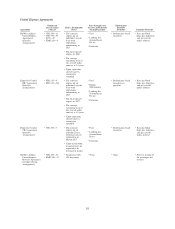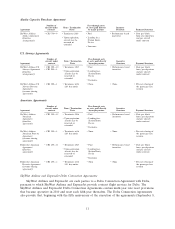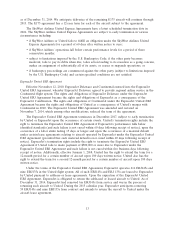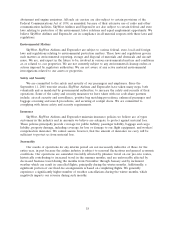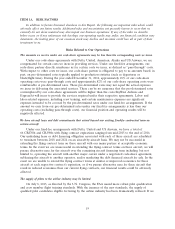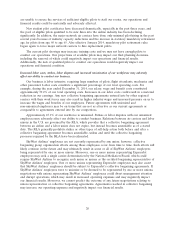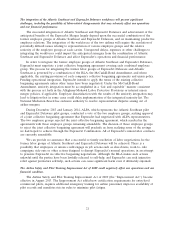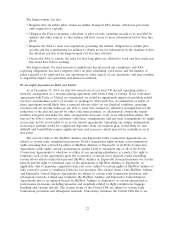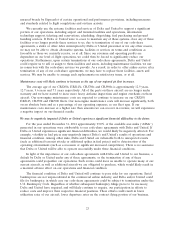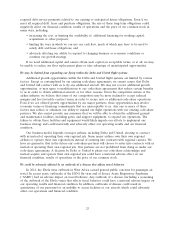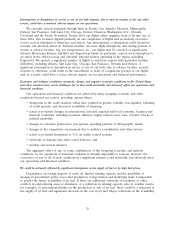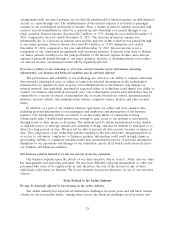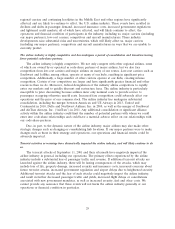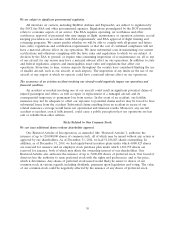SkyWest Airlines 2014 Annual Report Download - page 25
Download and view the complete annual report
Please find page 25 of the 2014 SkyWest Airlines annual report below. You can navigate through the pages in the report by either clicking on the pages listed below, or by using the keyword search tool below to find specific information within the annual report.are unable to secure the services of sufficient eligible pilots to staff our routes, our operations and
financial results could be materially and adversely affected.
New student pilot certificates have decreased dramatically, especially in the past three years, and
the pool of eligible pilots qualified to be new hires into the airline industry has been declining
significantly. In addition, the major network air carriers have done only minimal pilot hiring in the past
several years because of industry capacity reductions and the increase in statutory mandatory retirement
age for pilots from age 60 to age 65. Also effective January 2014, mandatory pilot retirement rules
began again to force major network carriers to hire replacement pilots.
The current pilot shortage may increase training costs and we may not have enough pilots to
conduct our operations. Our projections of available pilots may impact our fleet planning decisions,
including the removal of which could negatively impact our operations and financial results.
Additionally, the lack of qualified pilots to conduct our operations would negatively impact our
operations and financial condition.
Increased labor costs, strikes, labor disputes and increased unionization of our workforces may adversely
affect our ability to conduct our business.
Our business is labor intensive, requiring large numbers of pilots, flight attendants, mechanics and
other personnel. Labor costs constitute a significant percentage of our total operating costs. For
example, during the year ended December 31, 2014, our salary, wage and benefit costs constituted
approximately 39.2% of our total operating costs. Increases in our labor costs could result in a material
reduction in our earnings. Any new collective bargaining agreements entered into by other regional
carriers with their work forces may also result in higher industry wages and increased pressure on us to
increase the wages and benefits of our employees. Future agreements with unionized and
non-unionized employees may be on terms that are not as attractive as our current agreements or
comparable to agreements entered into by our competitors.
Approximately 45.1% of our workforce is unionized. Strikes or labor disputes with our unionized
employees may adversely affect our ability to conduct business. Relations between air carriers and labor
unions in the U.S. are governed by the RLA, which provides that a collective bargaining agreement
between an airline and a labor union does not expire, but instead becomes amendable as of a stated
date. The RLA generally prohibits strikes or other types of self-help action both before and after a
collective bargaining agreement becomes amendable, unless and until the collective bargaining
processes required by the RLA have been exhausted.
SkyWest Airlines’ employees are not currently represented by any union; however, collective
bargaining group organization efforts among those employees occur from time to time. Such efforts will
likely continue in the future and may ultimately result in some or all of SkyWest Airlines’ employees
being represented by one or more unions. Moreover, one or more unions representing ExpressJet
employees may seek a single carrier determination by the National Mediation Board, which could
require SkyWest Airlines to recognize such union or unions as the certified bargaining representative of
SkyWest Airlines’ employees. One or more unions representing ExpressJet employees may also assert
that SkyWest Airlines’ employees should be subject to ExpressJet’s collective bargaining agreements. If
SkyWest Airlines’ employees were to unionize or be deemed to be represented by one or more unions,
negotiations with unions representing SkyWest Airlines’ employees could divert management attention
and disrupt operations, which may result in increased operating expenses and may negatively impact
our financial results. Moreover, we cannot predict the outcome of any future negotiations relating to
union representation or collective bargaining agreements. Agreements reached in collective bargaining
may increase our operating expenses and negatively impact our financial results.
20


